# Coffee Module Three
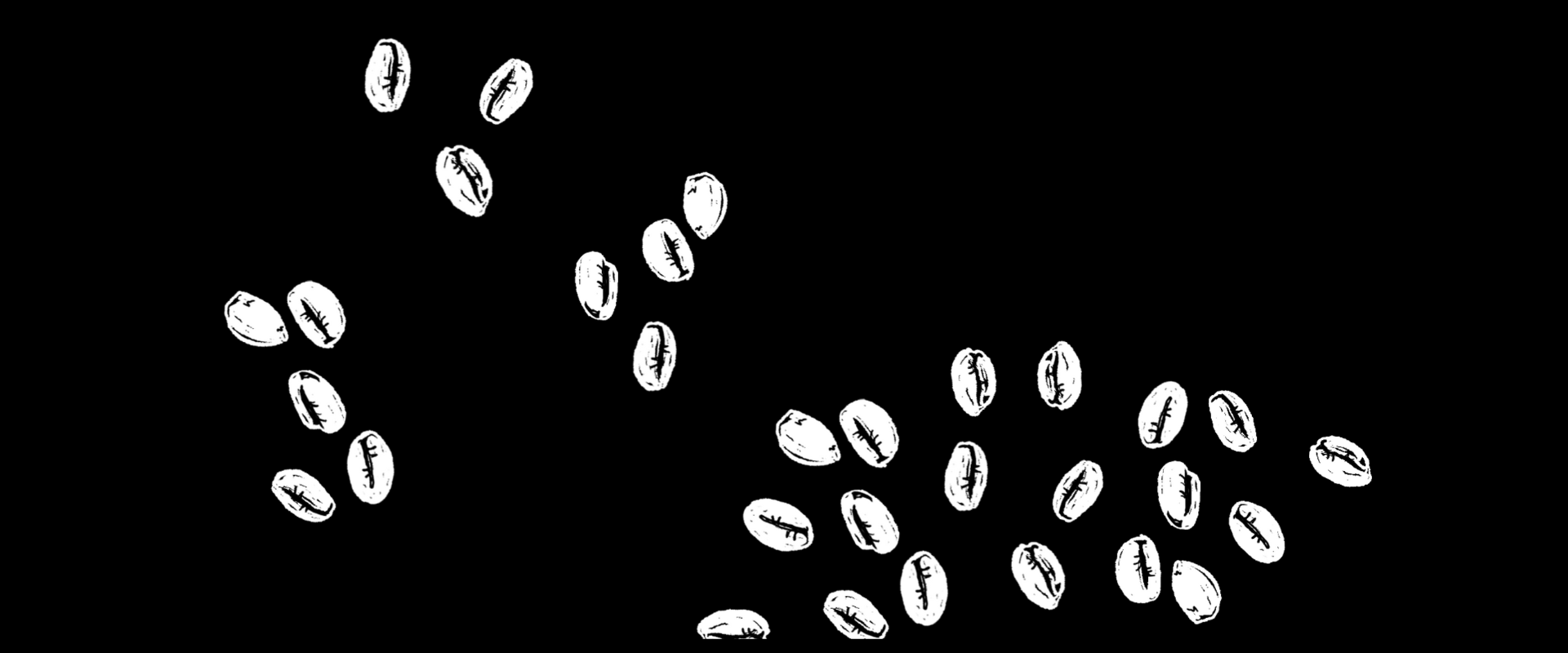
# Solubility
Extraction of coffee is essentially everything that the water takes from the coffee.
Water dissolves a lot of the coffee flavours and pretty much makes up everything we taste in a brewed cup of coffee, everything else is undissolved solids.
Roasted coffee is made up of 30% soluble solids and 70% insoluble solids (mostly cellulose).
We need both of these types of solids in our cup of coffee to create a balanced beverage, as both of these components have certain qualities and traits that are, or can be, positive or negative when too much or too little are present in a brew.

The soluble solids that are dissolved in brewed coffee contribute to its taste and strength, because the dissolved solids contain most of the coffees flavours. The soluble & volatile aromatics that are found in soluble compounds contribute to its aroma.
The insoluble solids that are present in a cup of soft brewed coffee consist of solids and oils held in suspension. These are generally made up of large protein molecules and fragments of coffee fibre. The insoluble solids and oils combine to form brew colloids, which contribute to aroma, body and taste. They also alter flavour by trapping and later releasing soluble solids and gases.
The insoluble solids that are in espresso are held in suspension or emulsion, these are primarily made up of coffee bean cell wall fragments, which contribute to body and not flavour.
The oils from the insoluble solids contribute to aroma, body and taste, it also helps to decrease the perception of bitterness in espresso by coating the tongue.
# Under Extraction
Under extraction occurs when you have not taken enough flavour out of the coffee, meaning that there is more flavour to be extracted out of the coffee to balance out the undesirable flavours. Common flavours that are associated with under-extraction are:
Sourness
Not to be confused with positive acidity. Sourness is when you taste an unbalanced and overwhelming tartness in the coffee and doesn’t have the sweetness to balance it out.
E.g. Lemon juice is SOUR, when diluted with water and balanced with sugar; the liquid then contains positive acidity that is palatable.
Lacking Sweetness
When extracting any coffee we want to extract as much sweetness as possible from that coffee, there is never too much sweetness in coffee.
Coffee Sugars (sweetness) is the last soluble component that is extracted out of coffee before reaching undesirable flavours associated with over extraction. So when a coffee is under extracted e.g. a ristretto shot, it is very sour and intense, as there’s not enough sweetness in the extraction to balance out the sourness.
Saltiness
Under-extracted coffees are salty, this is because salts are naturally found in the oils of coffee (green and roasted) and when roasted and extracted these oils are present in the form of crema.
If you do a ristretto shot of coffee and skim off the crema, and compare the saltiness of the crema and ristretto, the crema is significantly more salty and savoury in taste.
Salt and acid compounds are more soluble therefore under-extracted coffees are salty and sour, the sugars haven’t had enough time and/or water to dissolve into the brewed beverage.
Quick Finish
An under-extracted coffee will contain less flavour compounds when compared to a well extracted coffee. Because of this, under-extracted coffee will not present a lingering well lasted aftertaste because it just has less flavour in total, this won’t trigger all parts of your taste buds and will register the flavours being abrupt and unsatisfying.
# Over Extraction
Over extraction occurs when you take out too many soluble components from the coffee. This level of extraction promotes a lot of unfavourable flavours present in the cup. The two most common and obvious indications of over extraction are:
Bitterness
Coffee is bitter because it contains a high amount of caffeine, so we can’t escape bitterness in coffee, however when bitterness is the dominant taste profile of your coffee, that is a good indication of over extraction. There are hundreds of different chemicals in coffee that contribute with bitterness but caffeine being the main one.
Dry distillation is the part of coffee extraction that mostly is associated with darker roasted coffees, it's when you have reached over extraction and all the flavour compounds being extracted in this stage are just negative flavours. Most of them are bitter flavour profiles like ashy, burnt and smoky flavours.
Dryness
Dryness occurs most commonly in over extracted lighter roasted coffees. It’s a sensation that is very unpleasant and is more commonly referred to as astringency or tannic. It’s the same sensation as drinking an unsweetened black tea or biting into a seed of a grape, its “drying” on the palate.
This effect of dryness is caused by polyphenols, this chemical is found in plants, seeds and barks and because coffees are seeds of a fruit, it will contain these chemicals naturally.
Polyphenols are bitter and bind to your saliva’s protein dehydrating your tongue creating a sandpapery sensation.
# Ideal Extraction
An ideally extracted coffee is sweet with balanced positive acidity, clarity of flavours (sometimes complex) and a pleasant lingering finish.
What do these descriptors mean?
Sweetness
The sweeter the better, in specialty coffee we are striving for the coffees sweetest potential in extraction. We want to extract as much sugars out of the coffee as possible, without reaching over extraction where its masked by negative flavours.
Acidity
Complex and definable acids are what we are striving for, if the acid content resembles a familiar fruit then you’re getting closer to the ideal, but if you can pinpoint the type of fruit acidity and its variety, then you’ve nailed it.
Clarity
If you have over or under extraction with your coffee it will make it hard for you to understand the true flavour profile of the coffee you’re brewing, muddling up the flavours and giving you an unclear understanding of the coffee. You want to be able to taste the coffee and understand its full potential.
Finish
The finish should be long and pleasant.
# TDS (Total Dissolved Solids)
The amount of total dissolved solids in a brewed beverage will alter several things, but the two main factors would be your percentage of extraction and the strength of your brewed beverage.
The percentage of total dissolved solids in your brewed coffee means the amount of soluble solids that have dissolved from the actual ground coffee and are dissolved into the brewed coffee.
E.g. if your espresso reads of a TDS of 9% that means 9% of that brewed beverage is actual coffee particles, and if you have 100g of that espresso and dehydrated it, you will be left with 9g of actual coffee solids.
In order to measure the TDS% of a beverage sample we need to use a refractometer, it is a device that measures the deflection of light as it passes through something. By deflecting the light and measuring how much is being reflected we can measure the amount of solids in a liquid sample in percentage. Once we know the TDS % we can work out the extraction percentage of a brewed coffee.
Percentage of Extraction
Coffee is made up of soluble solids and insoluble solids, so the percentage of extraction determines how much of the coffee (insoluble and soluble) is extracted out of the coffee. The general percentage of extraction that is acceptable in specialty coffee is 18 – 22% (there can be exceptions though).
To calculate the extraction percentage of your coffee: Once you have your TDS % (reading from the refractometer) multiply TDS% x yield of beverage (weight of coffee) / divide by dose (amount of dry coffee used) = percentage of extraction.
Example for espresso: a espresso shot had a TDS of 8.3%, its dose was 20g, yield was 46g 8.3 (TDS) x 46 (yield) / 20 (dose) = 19.09% of extraction
This means that out of the 20 grams of dry coffee, I've used 19.09% of that in my final brewed beverage.
Example for soft brew coffee: a pour over brew had a TDS of 1.33%, dose was 12.5g, yield was 200g
1.33 (TDS) X 200 (yield) / 12.5 (dose) = 21.28% of extraction
Knowing the percentage of extraction is a good reference point to understanding how you’re extracting the coffee and to what degree of extraction you’re pushing it to.
Extraction is only relevant to flavour, never try to achieve a percentage of extraction without flavour in mind, once you’ve extracted a coffee to a desired flavour profile, then measure extraction to get the reference point.
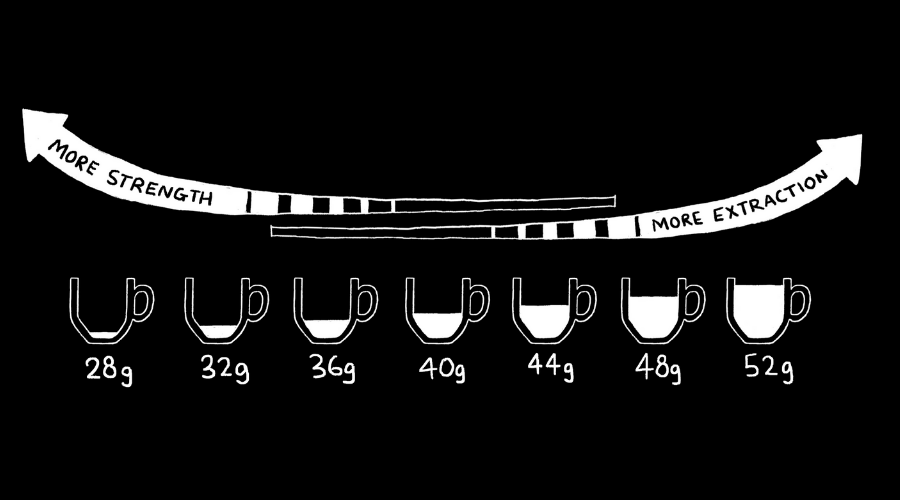
Strength of Beverage
This refers to the concentration of total dissolved coffee flavours also known as total dissolved solids (TDS).
To put it simply, it refers to the percentage of total brew. E.g. in espressos the strength of coffee generally will be between 7% -12% TDS, meaning 88% – 93% of the brewed coffee is water. In filter coffee the strength generally lies between 1.1% – 1.8% TDS, meaning 98.2% - 98.9% of the brewed coffee is water.
Coffee is an incredibly intense flavouring agent and to anyone with a trained palate 0.1% of a difference in strength is quite noticeable.
There are two main factors that are influenced by the strength of your beverage, intensity of flavour and tactile of the beverage (weight, body, mouth-feel).
Flavour Intensity
Strength of coffee will alter our perception of flavour, generally the higher the strength of a beverage, the harder it is for us to identify the coffees flavour. Even though the same coffee is used, at different strengths our palate will give us different perceived intensities of flavour. Weaker coffees allow us to taste more subtle flavours that are generally missed or masked in higher strength brews. E.g. filter brews can be ten times weaker.
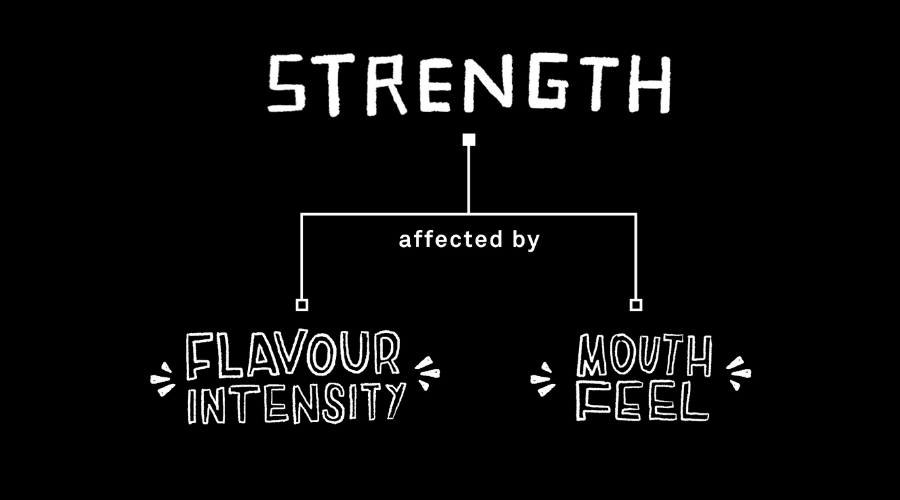
Tactile
The texture of a brewed coffee and its mouthfeel are one of the most important attributes to a great tasting coffee. Most consumers expect a certain level of texture, weight and body to their coffee, these do vary significantly depending on location and culture.

# Brew Pressure
Pre-infusion
This is the term we use to describe the stage of extraction where water is soaking in dry coffee without really passing through under pressure. This is done in most machines that use flow restrictors or pre-infusion chambers.
The water soaks the puck of dry coffee and swells it in place, trapping fines before the full brewing pressure hits. The expansion of the coffee cake significantly reduces the chance of channelling as well, as it allows the espresso machine to be more forgiving of flawed distribution, tamping or grind setting. Compared to extractions without pre-infusion, it tends to produce a slower rate of extraction especially towards the end of the extraction because of fines migration, the fines moving towards the bottom of the basket create a lot more resistance in extraction.
Common effective pre-infusion guidelines are 2-3 bars for 5-8 seconds to completely saturate the grounds.
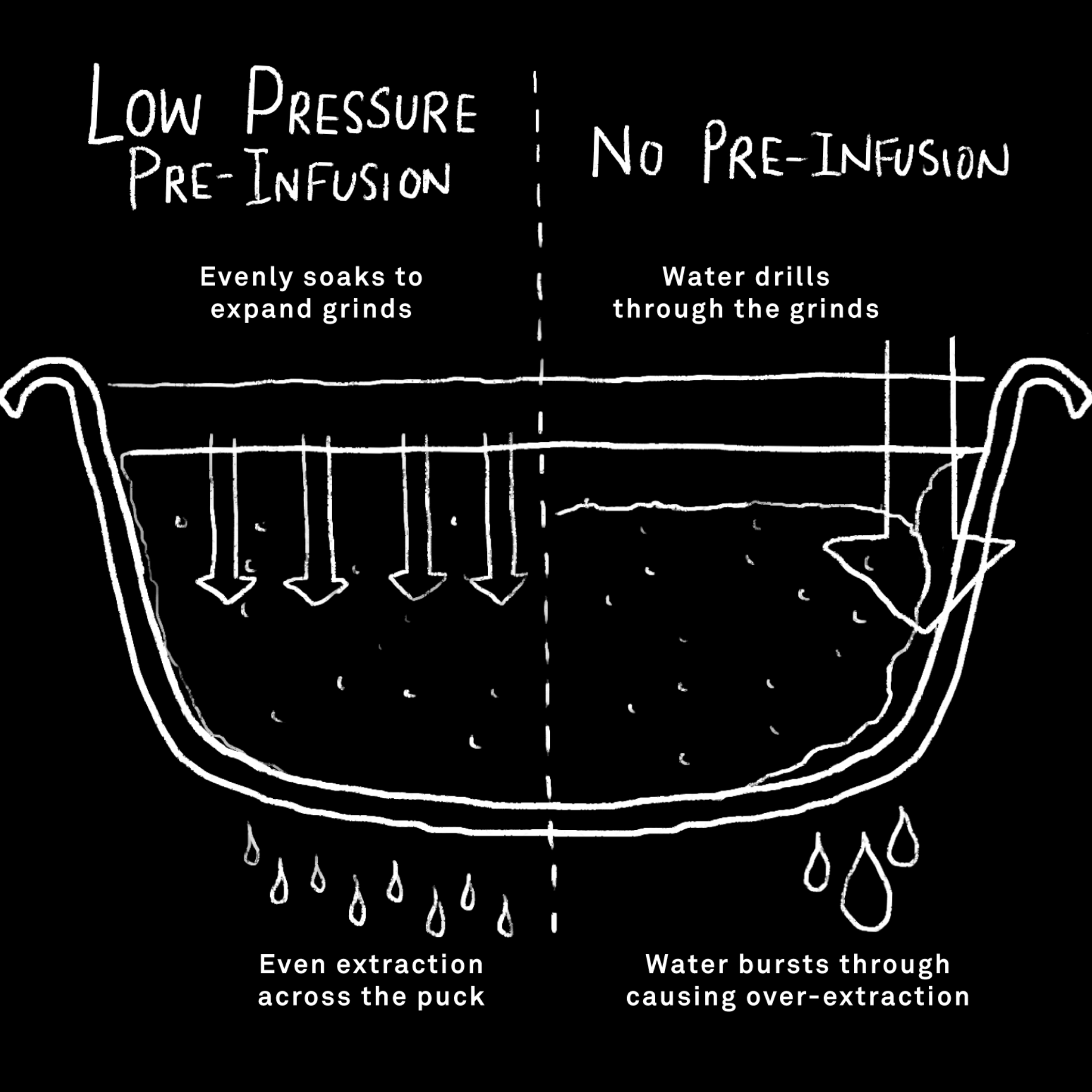
The Ramp Down
The reduction of extraction pressure from the middle to the end of extraction. It is to be believed that the reduction of the brewing pressure towards the end of the extraction process reduces the amount of bitterness and/or harsh flavours associated with the last part of the brewing process, as most of the desirable characteristics have been dissolved already. This is to add volume to aid in balance of flavours.
The ramp down period is generally 5-20% of the entire brew cycle and usually at a bar pressure of 5-8 bars, dependant on the coffee and other variables of course.

Graph indicates the ramp down in pressure avoids over extraction and reduces the chance of it from the last stage of the extraction process
Brewing Pressure
The magical brew pressure for espresso has always been set to as 9 bars, as this is the setting (on average) that has proven to be producing the best results. Because of how traditional espresso machines were built, the brew pressure had been measured to be at around 9 bars of atmospheric pressure. As the industry progressed in more advanced machinery, the coffee machines based it all around the old school lever machines, so they’ve kept it at the same 9 bars.
Because of this, everything we do now in the industry is to aid this e.g. how we roast, degree of roast, tamping techniques, distribution etc.
Certain brew pressures have been proven to bring out certain things out of the coffee and different bar pressures work better with different grind particles off different grinders e.g. coffees off the EK43 tend to extract better at lower brew pressures around 6-7 bars, however there are too many variables to consider if you’re trying to manipulate bar pressures to create desired flavours, and grind particle size is just one of them.
# Brew Temperature
The temperature of water used to extract espresso is another variable that can lead to a new list of questions from baristas and coffee professionals. Water temperature for brewing espresso will affect the strength of your coffee, flow rate and ultimately taste.
All you need to know about water temperature is that for espresso preparation the average temperature that most specialty coffee establishments use is around 90 – 96 degrees Celsius.
The most commonly used temperature at Code Black Coffee is 93 degrees Celsius, the reason for this is because of the coffee we are using, we quality control our coffees at 93 degrees and base it around that temperature. Anything significantly higher or lower than this tends to extract certain negative qualities out of the coffee or promote unbalanced espressos.
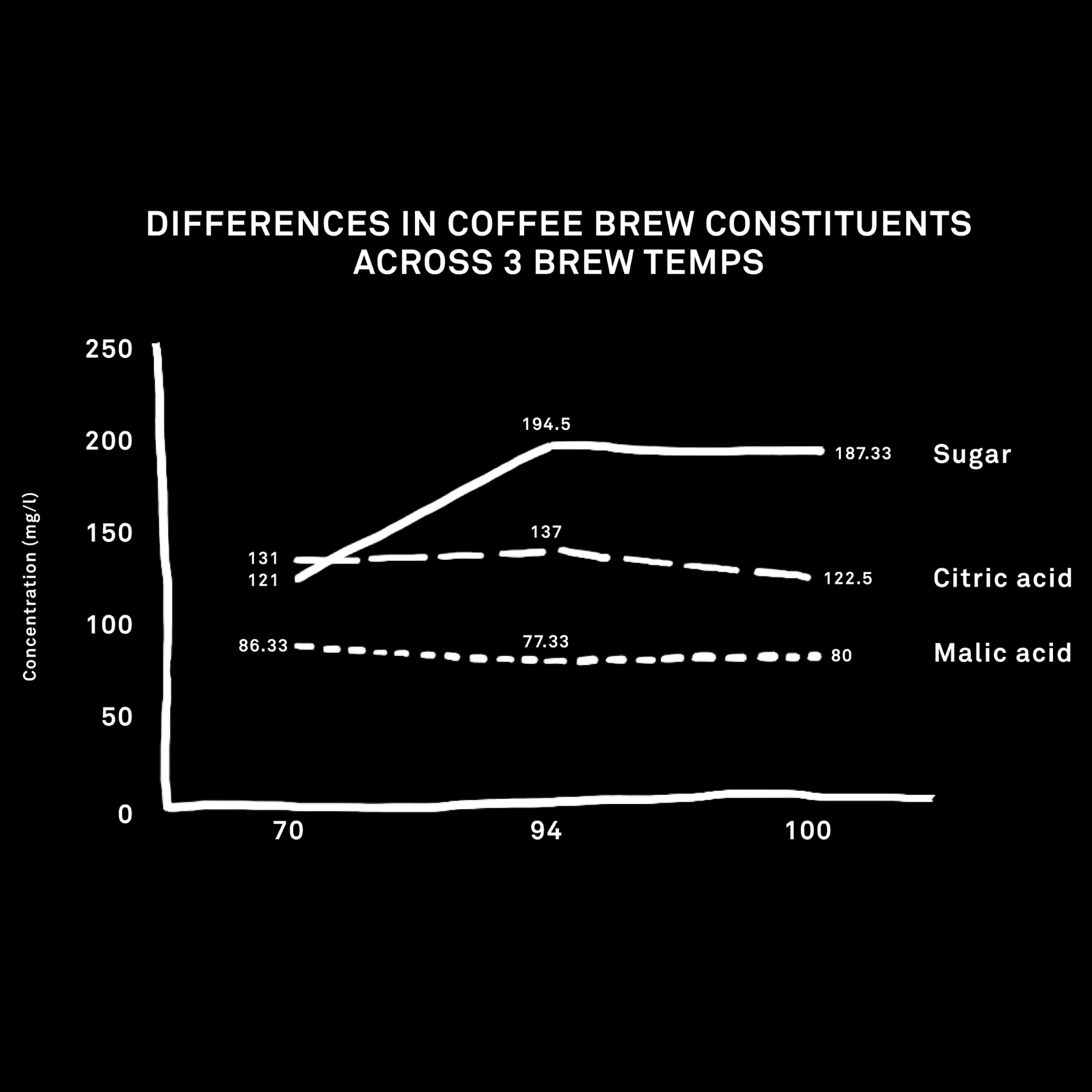
Graph indicates that excessive differences in brew temperatures bring out different amounts of elements in coffee that make it positive or negative, this is all dependent on the coffee of course
Lower Temperatures
- Can be used to overcome the high solubility of over roasted / over developed coffees
- Decrease extraction yield
- Decrease body
- Decrease sweetness
- Decrease bitterness
- Increase acidity
- Decreased espresso flow rate
Higher Temperatures
- Can compensate for lighter roasted less developed coffees, as it will aid in extracting a more insoluble coffee
- Increase extraction yield percentage
- Increase in body
- Increase in sweetness
- Increased bitterness
- Decrease acidity
- Increased espresso flow rate

# Dial In / Troubleshooting
Extractions – Dial In
The only way you can identify problems with extractions are if your extraction techniques are kept at a constant and you are promoting as much “even” extraction as possible e.g. even tamping / consistent grind size / even distribution / clean screens / etc.
Being able to identify positive and negative flavour attributes from extraction is a very important skill in a good barista, this skill comes with practice in tasting. Tasting the same coffees with different extractions e.g. changing the extraction times and/or yields to bring out different flavours will help you understand what changing each variable will do and bring out of the coffee.
Below is an espresso compass to help you identify where are extractions are sitting and point out a direction on how you can improve your extraction if it’s not at your desired flavour profile.
Be aware that if you increase your yield you are simultaneously making your coffee weaker and increasing your extraction and if you are decreasing your yield you are increasing the strength and decreasing extraction.
Flavour Breakdown when Tasting Coffee
Check for intensities of the different attributes in coffee when you are tasting to help you identify the problem e.g.

Once you have pointed out the intensities of each attribute, you are now able to determine whether the brewed coffee is correctly brewed, ideally you want a “balanced” coffee, however some coffees won’t allow you to achieve this so aiming for optimum extraction is the goal.
It can mean aiming for maximum sweetness without dominant bitterness or dryness, with a good strength or mouth feel (not too watery or thin).
OR
Achieving a balanced brew where the acidity, sweetness and bitterness all matched, in this case if acidity and sweetness are matched but bitterness is lower than the two, that is also a good extraction with a good strength or mouth feel (not too watery or thin).
Using yield to manipulate flavour When you increase the yield you are increasing the amount of water content of the beverage and increasing extraction. What that will do in terms of changing the flavour intensities is:
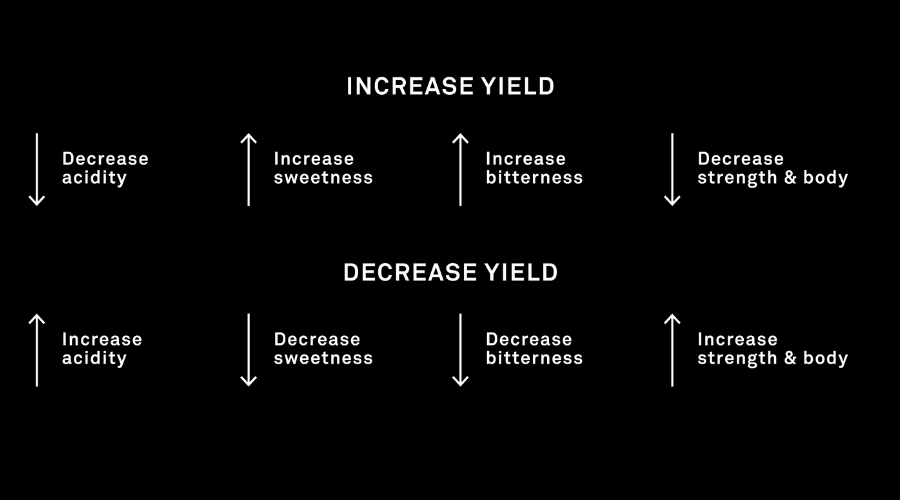
Using time to manipulate flavour When you increase the time, you are increasing the contact time of water to the coffee of the beverage and increasing extraction. What that will do in terms of changing the flavour intensities is:
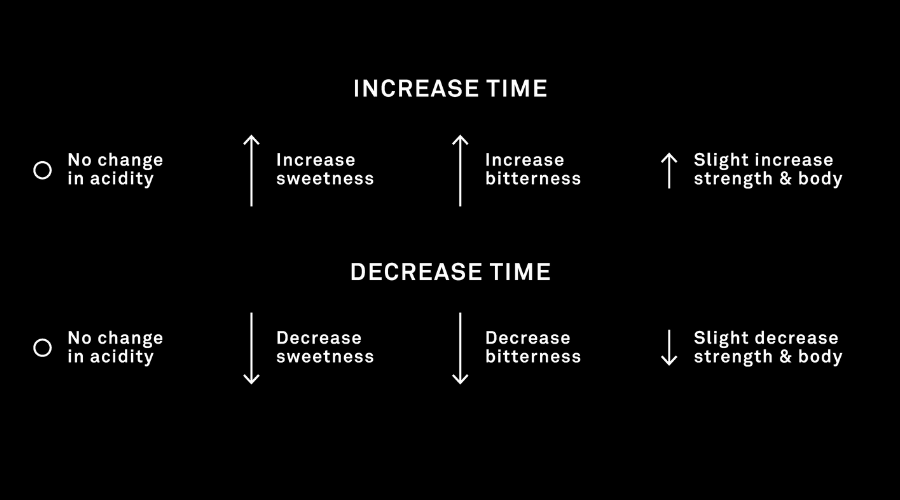
In most cases it is required for you to change both yield and time in order to achieve an optimum extraction.
To be able to achieve this successfully you need to understand where the problem is by tasting the coffee and identifying what it lacks, or what is has too much of, by plotting it on the intensities chart.
E.g. let's say a coffee at a yield of 48g and a time of 24 seconds it gave us this result on the chart.

Because the acidity is so high we can’t just fix it by increasing contact time to bring up the sweetness and bitterness to achieve balance.
First we will need to reduce the acidity by diluting the drink with a larger yield e.g. 52g, this would have also made our beverage sweeter and more bitter, reducing the strength and body. This is what it looks like now:
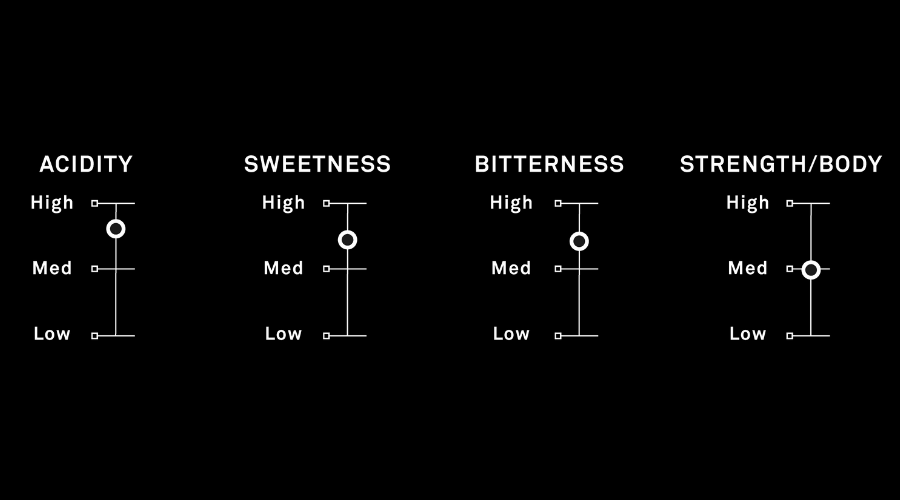
Now that these intensities are getting closer to balance, we can use time to balance it out, by increasing the contact time for example from 24 seconds to 27 seconds we will increase the sweetness and bitterness to match the acidity. We don’t want the beverage to get any weaker or have less body than where it is now.
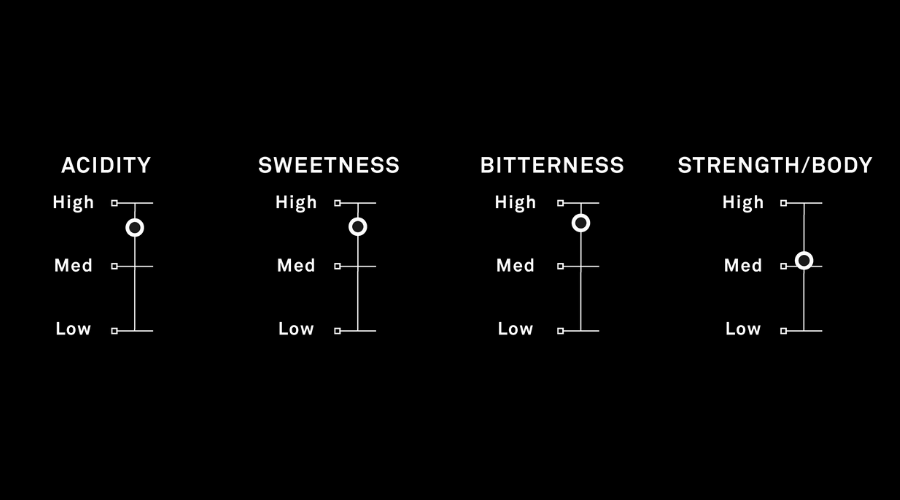
By manipulating the yield and time we are able to balance out the flavours of the coffee where the acidity, sweetness and bitterness are matched and the body of the beverage isn’t too thin.
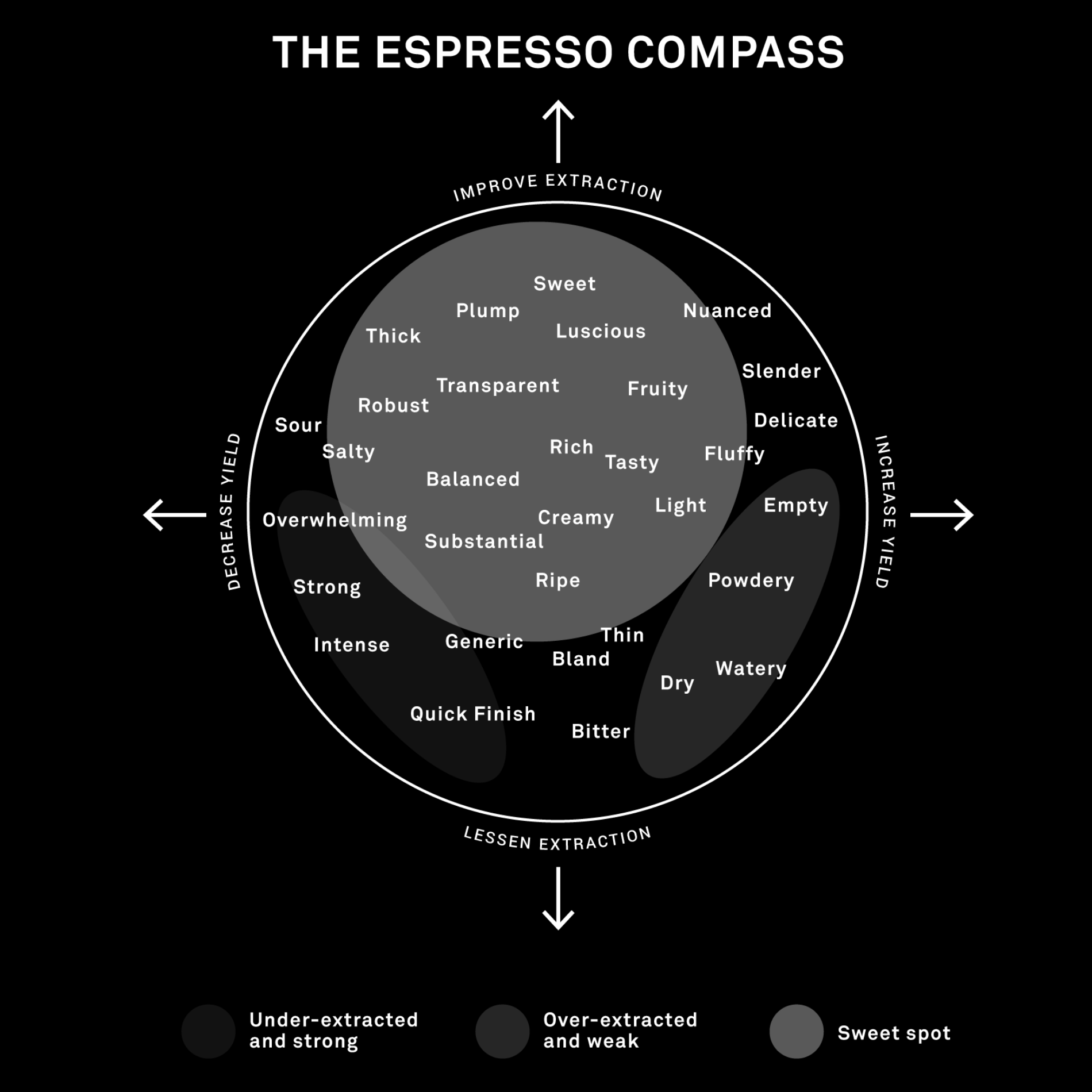
Improve your extraction:
Distribute grinds evenly and by using a good grinder, flat and snug tamper, VST baskets and a well developed roast.
Increase your extraction:
Make it more even or by using a finer grind setting (time increase). Don't grind too finely or extraction will become uneven and decline.
When adjusting yield:
Do not change the dose. Time will change as a result. Only adjust grind if your shot time is too far off.
A more even (improved) extraction is always desirable because it:
- Creates a larger sweet spot
- Allows for richer and sweeter espresso
- Intensifies positive and unique flavours
- Diminishes negative and generic flavours
- Is more efficient
If you're tasting bitterness and sourness together, your extraction is likely uneven because they can co-exist there. An even extraction has more room for barista expression and exploration of the coffee's unique flavours without distraction.
# Grind Sizes
Extractions with different grinders
Different grinders will have different burr material, burr size, burr shape and grinding speed, all these differences will obviously give you a different grind size and/or shape of coffee grinds. Because of this you will need different extraction recipes.
This is a graph that indicates the varied grind sizes of different burrs.
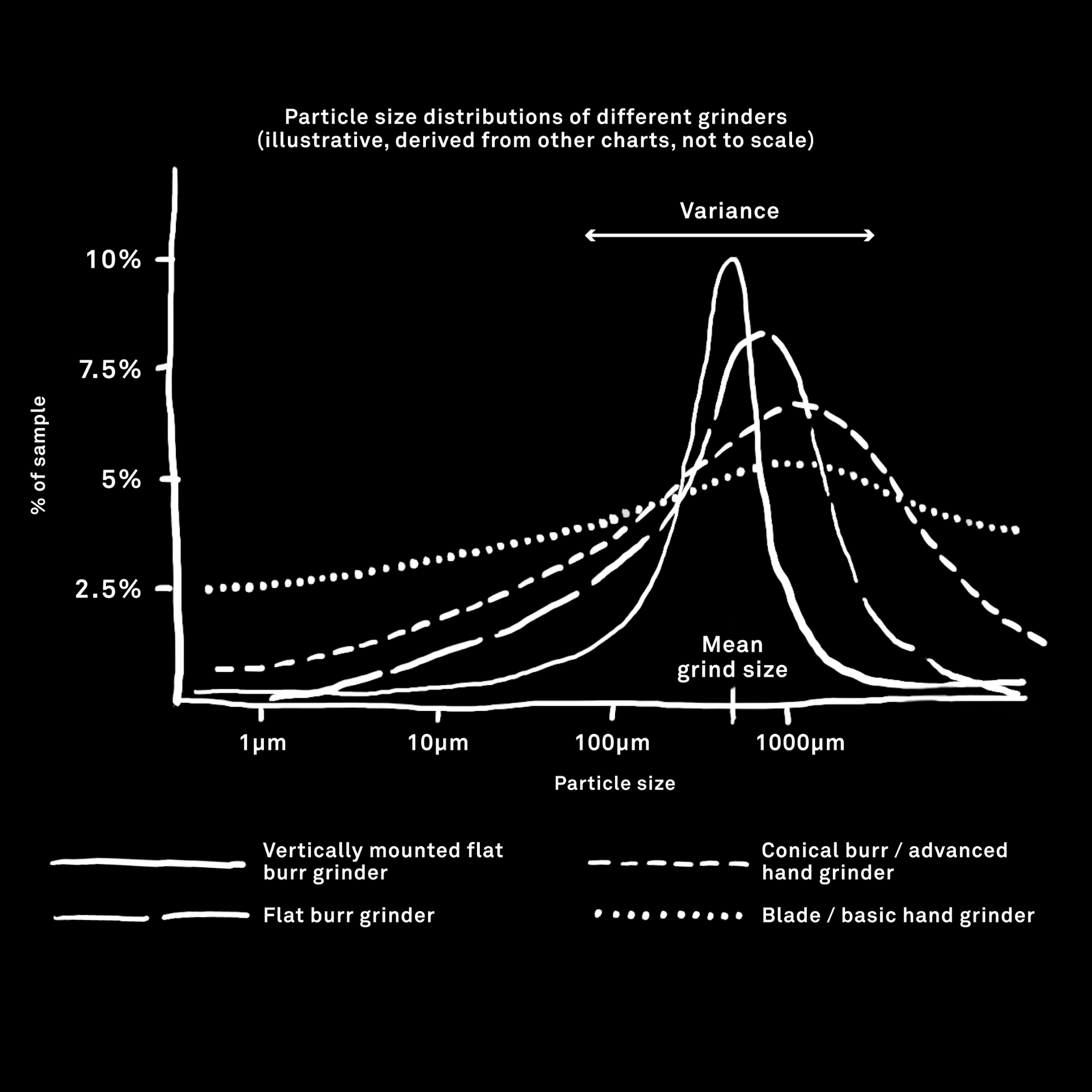
The grinders that produce the largest variance in grind sizes are the blade and basic hand grinders, because of this you won’t be able to achieve even extraction as the different grind particles will hit optimum extraction at different times.
Conical burr grinders (e.g. Robur Electronic Mazzer and advanced hand grinders) still produce a large variance in grind sizes which is the main reason why extractions from these grinders tend to be significantly less than flat burrs. The larger particles will tend to be under extracted and the small finer particles will be over extracted. On average Conical burrs produce extractions at around 17 – 19%
Flat Burr grinders (e.g. Mythos One and the DC One grinders) produce very consistent grind size particles and allow a large percentage of the total grind particles to hit optimum extraction. On average flat burr grinders produce extractions at around 18 – 20%
Vertical Flat Burr grinders (e.g. EK 43) produce very consistent grind sizes which allow most of the grind particles to reach the same/ similar extraction point, averaging from 20 – 22%.